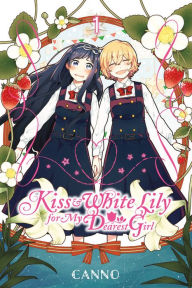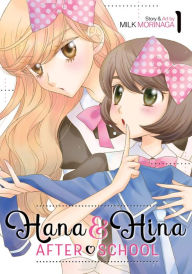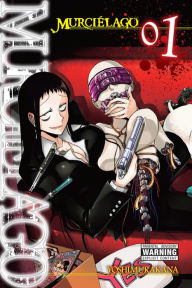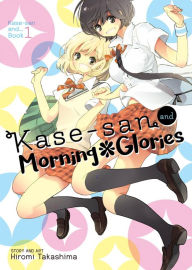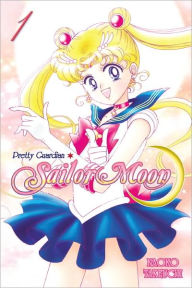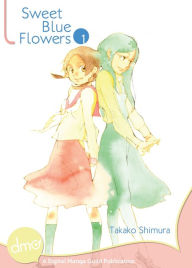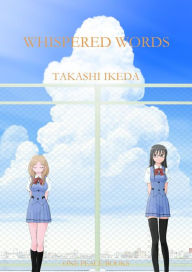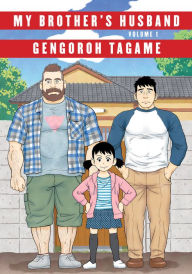Defining Yuri Manga: A Q&A with Erica Friedman
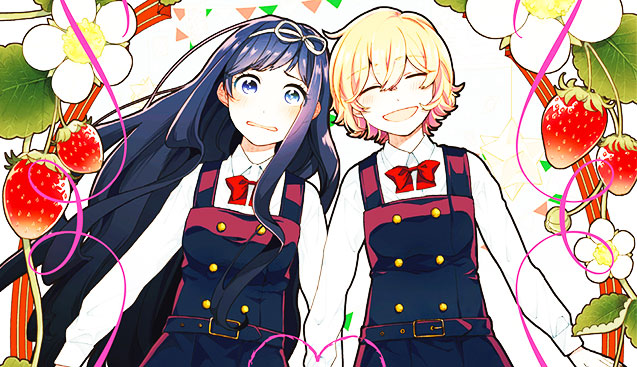 This week, Yen Press published the first volume of Kiss and White Lily for My Dearest Girl. It’s a yuri manga, a high school romance about two girls, and reading it got me thinking that I needed to know more about the yuri genre. And that led me to my friend Erica Friedman, who is the founder of the fan organization Yuricon and herself a former publisher of yuri manga. If you want to go deep on the subject, check out her blog, Okazu, where she writes about Yuri anime, manga and related media. I asked Erica to explain a bit about yuri, both inside and outside of Japan, and recommend some favorite titles.
This week, Yen Press published the first volume of Kiss and White Lily for My Dearest Girl. It’s a yuri manga, a high school romance about two girls, and reading it got me thinking that I needed to know more about the yuri genre. And that led me to my friend Erica Friedman, who is the founder of the fan organization Yuricon and herself a former publisher of yuri manga. If you want to go deep on the subject, check out her blog, Okazu, where she writes about Yuri anime, manga and related media. I asked Erica to explain a bit about yuri, both inside and outside of Japan, and recommend some favorite titles.
Kiss and White Lily for My Dearest Girl, Vol. 1
Kiss and White Lily for My Dearest Girl, Vol. 1
By Canno
Paperback $13.00
How would you define yuri manga?
Broadly, yuri is any story with lesbian themes.
To really understand yuri, it’s best to start with the four demographic genres. Most manga in Japan is categorized not by topic, but by the demographics of audience: for girls (shojo), for boys (shonen), for women (josei), for men (seinen).
Boy’s Love (yaoi) was developed by creators of manga for girls and for women. The tropes of BL are tropes that developed by and for this fairly homogenous assumed audience of straight women.
Yuri is the only genre of manga that doesn’t have an assumed homogenous audience. Yuri developed organically in all four demographic genres with tropes from that genre imposed on the stories. So yuri by men for men and by women for women isn’t going to have all that much in common….except that it’s “yuri.”
Which is why the official Yuricon definition of yuri is “any anime or manga series (or other derivative media, i.e., fan fiction, film, etc.) that shows intense emotional connection, romantic love, or physical desire between women. Yuri is not a genre confined by the gender or age of the audience, but by the perception of the audience.”
Who are the writers, who are the readers, are there particular genres that predominate?
Because of the above broad definition, this question becomes almost impossible to answer!
Based on surveys we’ve done over the years on Okazu and Yuricon, the readers are very close to evenly split between women and men, although they may read different yuri series, and also read them differently. I’d call it 55 percent women and 45 percent men. Readers also are fairly split across most adult age groups. Because of the heterogeneity of readers, I often say yuri is for anyone who wants to read yuri.
How would you define yuri manga?
Broadly, yuri is any story with lesbian themes.
To really understand yuri, it’s best to start with the four demographic genres. Most manga in Japan is categorized not by topic, but by the demographics of audience: for girls (shojo), for boys (shonen), for women (josei), for men (seinen).
Boy’s Love (yaoi) was developed by creators of manga for girls and for women. The tropes of BL are tropes that developed by and for this fairly homogenous assumed audience of straight women.
Yuri is the only genre of manga that doesn’t have an assumed homogenous audience. Yuri developed organically in all four demographic genres with tropes from that genre imposed on the stories. So yuri by men for men and by women for women isn’t going to have all that much in common….except that it’s “yuri.”
Which is why the official Yuricon definition of yuri is “any anime or manga series (or other derivative media, i.e., fan fiction, film, etc.) that shows intense emotional connection, romantic love, or physical desire between women. Yuri is not a genre confined by the gender or age of the audience, but by the perception of the audience.”
Who are the writers, who are the readers, are there particular genres that predominate?
Because of the above broad definition, this question becomes almost impossible to answer!
Based on surveys we’ve done over the years on Okazu and Yuricon, the readers are very close to evenly split between women and men, although they may read different yuri series, and also read them differently. I’d call it 55 percent women and 45 percent men. Readers also are fairly split across most adult age groups. Because of the heterogeneity of readers, I often say yuri is for anyone who wants to read yuri.
Hana and Hina After School, Vol. 1
Hana and Hina After School, Vol. 1
Paperback $12.99
Probably the best-known yuri artist for the English-reading audience is Milk Morinaga, as Seven Seas has had pretty good success with her books. Top authors in Japan include Takemiya Jin and Morishima Akiko, whose work I would love to see translated; two of my favorites are Nishi UKO and Nakamura Kiyo, both of whom create works about adults for adult readers.
“Yuri” in the west is predominantly high-school romance, because that is both safe and cute. But some of the best yuri I’ve read is darker. Gunjo by Nakamura Kiyo is one of the best manga I have ever read. And we’re getting Murcielago by Yoshimura Kana in English this year from Yen Press, which is not “good” in any sense, but I enjoy it immensely. Both are very violent and and very adult, but where Gunjo is sublime, Murcielago is violent and gross. [laugh]
Probably the best-known yuri artist for the English-reading audience is Milk Morinaga, as Seven Seas has had pretty good success with her books. Top authors in Japan include Takemiya Jin and Morishima Akiko, whose work I would love to see translated; two of my favorites are Nishi UKO and Nakamura Kiyo, both of whom create works about adults for adult readers.
“Yuri” in the west is predominantly high-school romance, because that is both safe and cute. But some of the best yuri I’ve read is darker. Gunjo by Nakamura Kiyo is one of the best manga I have ever read. And we’re getting Murcielago by Yoshimura Kana in English this year from Yen Press, which is not “good” in any sense, but I enjoy it immensely. Both are very violent and and very adult, but where Gunjo is sublime, Murcielago is violent and gross. [laugh]
Murciélago, Vol. 1
Murciélago, Vol. 1
By
Yoshimurakana
Translator
Christine Dashiell
In Stock Online
Paperback $13.00
Is the category defined differently in Japan than in North America?
Because yuri is not like any of the older genres, and comes from three completely disparate origins—what creators want to create, what readers want to read and what companies want to sell—it has a pretty schizoid definition issue. In fact, I have an article coming out this summer in Transformative Works and Culture on this very topic.
I’ll get emails from folks who watch an anime in which girls with unrealistic bodies grope each other [that] say “check this yuri anime out!” and I think, “that’s not yuri.” They see two girls groping and think “yuri” and I see “creepy fanservice for people who don’t know how breasts work.” [laugh] But this isn’t a definition issue between Japan and the west, so much as the individual. Plenty of Japanese folks would look at that and think “yuri” too. Maybe the main difference is that lesbians look at yuri differently than straight folks? I’m looking for characters with some actual emotional connection, not just engaging in fanservice.
How big a part is it of the manga world in Japan?
Microscopic. [laughs] It’s a small niche in manga publishing. Most manga stores don’t have a “yuri” section as such. Toranoana in Akihabara had one the last time I was there. It was incredibly exciting to see multiple publishers and media in one section. I bought a ton of stuff I might never have found otherwise. (Most of it was terrible, but I found a few great titles, as well.)
You often write about Comic Yuri Hime at Okazu. What’s it like? Are there other yuri magazines?
At the moment, Comic Yuri Hime is the only all-yuri manga magazine. It began life in 2005, when Ichijinsha bought the existing stories running in the first yuri manga magazine, Yuri Shimai. It started as a quarterly magazine. For a few years, it split into two volumes, Yuri Hime (for women) and Yuri Hime S (for men), both quarterly, but in 2011 they remerged, and the magazine relaunched as a bimonthly. Starting in 2017, the magazine has gone monthly—the first ever monthly yuri manga magazine! It’s very exciting.
Is the category defined differently in Japan than in North America?
Because yuri is not like any of the older genres, and comes from three completely disparate origins—what creators want to create, what readers want to read and what companies want to sell—it has a pretty schizoid definition issue. In fact, I have an article coming out this summer in Transformative Works and Culture on this very topic.
I’ll get emails from folks who watch an anime in which girls with unrealistic bodies grope each other [that] say “check this yuri anime out!” and I think, “that’s not yuri.” They see two girls groping and think “yuri” and I see “creepy fanservice for people who don’t know how breasts work.” [laugh] But this isn’t a definition issue between Japan and the west, so much as the individual. Plenty of Japanese folks would look at that and think “yuri” too. Maybe the main difference is that lesbians look at yuri differently than straight folks? I’m looking for characters with some actual emotional connection, not just engaging in fanservice.
How big a part is it of the manga world in Japan?
Microscopic. [laughs] It’s a small niche in manga publishing. Most manga stores don’t have a “yuri” section as such. Toranoana in Akihabara had one the last time I was there. It was incredibly exciting to see multiple publishers and media in one section. I bought a ton of stuff I might never have found otherwise. (Most of it was terrible, but I found a few great titles, as well.)
You often write about Comic Yuri Hime at Okazu. What’s it like? Are there other yuri magazines?
At the moment, Comic Yuri Hime is the only all-yuri manga magazine. It began life in 2005, when Ichijinsha bought the existing stories running in the first yuri manga magazine, Yuri Shimai. It started as a quarterly magazine. For a few years, it split into two volumes, Yuri Hime (for women) and Yuri Hime S (for men), both quarterly, but in 2011 they remerged, and the magazine relaunched as a bimonthly. Starting in 2017, the magazine has gone monthly—the first ever monthly yuri manga magazine! It’s very exciting.
Kase-san and Morning Glories (Kase-san and... Book 1)
Kase-san and Morning Glories (Kase-san and... Book 1)
In Stock Online
Paperback $13.99
Manga magazines in Japan are shaped mostly by editorial fiat and reader feedback. CYH has had a lot of popular yuri artists, but also has lost a lot of them as well. They run new artists contests all the time, as the more experienced (and, let’s face it, more expensive) artists leave. Sometimes those lead to great new talent. Sometimes, it leads to issues in which 80 percent of the content is “schoolgirls in love.”
There were a few years, between 2010 and 2014, in which we had three yuri manga magazines to choose from. Sales were okay, but putting out a small print run magazine in Japan is still pretty expensive and a lot of the artists have either gotten together to work on small-press collections, or moved on to other ventures.
The upcoming Kase-san series (Kase-san and Morning Glory, Kase-san and Bento, Kase-san and Shortcake) all ran in a magazine called Pure Yuri Anthology Hirari. It was a lovely series, and I’m glad has Seven Seas licensed it.
Are there particular tropes that pop up over and over in yuri manga?
How long do we have? [laughs] I wrote a 2-part article about this very topic called “40 Years of the Same Damn Story,” in which I traced the history of the two most common tropes.
The “typical” yuri couple is often represented by an emotional/moody traditional Japanese beauty, with long black hair and a younger, more naïve and cheerful girl with lighter hair. The first part of my article traces this couple back from early 20th-century Japanese girl’s literature, through what I consider to be the first yuri manga, Shiroi Heya no Futari, to the present.
Manga magazines in Japan are shaped mostly by editorial fiat and reader feedback. CYH has had a lot of popular yuri artists, but also has lost a lot of them as well. They run new artists contests all the time, as the more experienced (and, let’s face it, more expensive) artists leave. Sometimes those lead to great new talent. Sometimes, it leads to issues in which 80 percent of the content is “schoolgirls in love.”
There were a few years, between 2010 and 2014, in which we had three yuri manga magazines to choose from. Sales were okay, but putting out a small print run magazine in Japan is still pretty expensive and a lot of the artists have either gotten together to work on small-press collections, or moved on to other ventures.
The upcoming Kase-san series (Kase-san and Morning Glory, Kase-san and Bento, Kase-san and Shortcake) all ran in a magazine called Pure Yuri Anthology Hirari. It was a lovely series, and I’m glad has Seven Seas licensed it.
Are there particular tropes that pop up over and over in yuri manga?
How long do we have? [laughs] I wrote a 2-part article about this very topic called “40 Years of the Same Damn Story,” in which I traced the history of the two most common tropes.
The “typical” yuri couple is often represented by an emotional/moody traditional Japanese beauty, with long black hair and a younger, more naïve and cheerful girl with lighter hair. The first part of my article traces this couple back from early 20th-century Japanese girl’s literature, through what I consider to be the first yuri manga, Shiroi Heya no Futari, to the present.
Sailor Moon, Volume 1
Sailor Moon, Volume 1
Paperback $10.99
The second most common trope is the “Girl Prince.” In the second part, I trace this character back to Heian period literature, through Rose of Versailles and Sailor Moon, Revolutionary Girl Utena, to the present.
There are other tropes, like two girls sharing a room in a tower or garret, or the setting of a typical yuri story being an elite (almost fantastically so) private school.
Can you tell me how yuri manga first came to be? Was there a particular book or series that is an important milestone, as Heart of Thomas is for yaoi?
Yuri has literary roots from the early 20th century in Japan. The novel I tend to point to as the proto-“yuri” novel is Yoshiya Nobuko’s Yaneura no Nishojo (Two Maidens in the Attic). That novel established a lot of the typical yuri genre tropes.
Yuri manga developed organically along with BL. During the same period of time Takaemiya Keiko and Moto Hagio were drawing Song of the Wind and Trees and Heart of Thomas, Yamgishi Ryouko was creating what I consider the earliest yuri manga, Shiroi Heya no Futari (Our White Room)which established that main “yuri couple” tropes we spoke of earlier.
In Shiroi Heya no Futari, a cheerful and naïve girl, Resine, transfers to an elite private school “in France” where she rooms in the garret with emotional and fragile, yet compellingly beautiful, Simone. They fall in love, but obviously cannot live happily ever after, so to free Resine, Simone dies a pointless and tragic death. The ending was a major step back from the triumphant end in Yaneura no Nishojo, but was rather typical of the time.
Do American publishers prefer certain types of yuri, or prefer to work with certain Japanese publishers? How does that affect what we see here, as opposed to what would be available to a Japanese-speaking reader?
The issues faced by yuri creators are very similar here in America and in Japan—most of the publishers and editors are men, who are inclined to license what they like and what they think they can sell to a broad audience. So creators who are drawing stories of adult women in relationships tend to not get licensed, where fantasies about schoolgirls in not-real lives (no adults, no men, no queer identity, no real life LGBTQ+ issues) tend to be more appealing to them. Publishers on both sides definitely seem to favor the infantilized schoolgirl narrative and moe-style art above anything else. That said, there are titles in Japan and in America that buck that trend, and some popular manga artists who do schoolgirl narrative are starting to sneak queer identity into their stories, so I think there’s hope!
What trends are you seeing in yuri manga?
The inclusion of queer identity in yuri manga is the most important trend and I meant that it is *important* in a real-life way. Yuri manga so often tends to focus on the realization of like/love/lust and end with an acknowledgement. As I often put it, “There is a girl, she likes a girl, the girl likes her, they like each other, the end.” This is changing. Not quickly, not in a fell swoop, but there is change.
The other trend, which I like a lot, for much the same reasons as above, is the publishing of Comic Essays by and about adult lesbians. One of these, My Lesbian Experience With Loneliness, will be coming out this year from Seven Seas. It was a Pixiv-platform webcomic by Kabi Nagata on her experiences fighting depression and an eating disorder, and how she found herself eventually.
What yuri titles would you recommend for a first-time reader?
This is a good year to be asking this question, as there are a number of good yuri manga coming out in English this year.
I’ll stick with three titles for brevity:
The second most common trope is the “Girl Prince.” In the second part, I trace this character back to Heian period literature, through Rose of Versailles and Sailor Moon, Revolutionary Girl Utena, to the present.
There are other tropes, like two girls sharing a room in a tower or garret, or the setting of a typical yuri story being an elite (almost fantastically so) private school.
Can you tell me how yuri manga first came to be? Was there a particular book or series that is an important milestone, as Heart of Thomas is for yaoi?
Yuri has literary roots from the early 20th century in Japan. The novel I tend to point to as the proto-“yuri” novel is Yoshiya Nobuko’s Yaneura no Nishojo (Two Maidens in the Attic). That novel established a lot of the typical yuri genre tropes.
Yuri manga developed organically along with BL. During the same period of time Takaemiya Keiko and Moto Hagio were drawing Song of the Wind and Trees and Heart of Thomas, Yamgishi Ryouko was creating what I consider the earliest yuri manga, Shiroi Heya no Futari (Our White Room)which established that main “yuri couple” tropes we spoke of earlier.
In Shiroi Heya no Futari, a cheerful and naïve girl, Resine, transfers to an elite private school “in France” where she rooms in the garret with emotional and fragile, yet compellingly beautiful, Simone. They fall in love, but obviously cannot live happily ever after, so to free Resine, Simone dies a pointless and tragic death. The ending was a major step back from the triumphant end in Yaneura no Nishojo, but was rather typical of the time.
Do American publishers prefer certain types of yuri, or prefer to work with certain Japanese publishers? How does that affect what we see here, as opposed to what would be available to a Japanese-speaking reader?
The issues faced by yuri creators are very similar here in America and in Japan—most of the publishers and editors are men, who are inclined to license what they like and what they think they can sell to a broad audience. So creators who are drawing stories of adult women in relationships tend to not get licensed, where fantasies about schoolgirls in not-real lives (no adults, no men, no queer identity, no real life LGBTQ+ issues) tend to be more appealing to them. Publishers on both sides definitely seem to favor the infantilized schoolgirl narrative and moe-style art above anything else. That said, there are titles in Japan and in America that buck that trend, and some popular manga artists who do schoolgirl narrative are starting to sneak queer identity into their stories, so I think there’s hope!
What trends are you seeing in yuri manga?
The inclusion of queer identity in yuri manga is the most important trend and I meant that it is *important* in a real-life way. Yuri manga so often tends to focus on the realization of like/love/lust and end with an acknowledgement. As I often put it, “There is a girl, she likes a girl, the girl likes her, they like each other, the end.” This is changing. Not quickly, not in a fell swoop, but there is change.
The other trend, which I like a lot, for much the same reasons as above, is the publishing of Comic Essays by and about adult lesbians. One of these, My Lesbian Experience With Loneliness, will be coming out this year from Seven Seas. It was a Pixiv-platform webcomic by Kabi Nagata on her experiences fighting depression and an eating disorder, and how she found herself eventually.
What yuri titles would you recommend for a first-time reader?
This is a good year to be asking this question, as there are a number of good yuri manga coming out in English this year.
I’ll stick with three titles for brevity:
Hana and Hina After School, Vol. 1
Hana and Hina After School, Vol. 1
Paperback $12.99
Hana and Hina Afterschool, by Milk Morinaga
Morinaga has a formula and in this series it works. Two girls who are opposites meet and fall in love. Contemporary yuri schoolgirl romance for a primarily male audience, with a little bit of identity. (3 volumes)
Hana and Hina Afterschool, by Milk Morinaga
Morinaga has a formula and in this series it works. Two girls who are opposites meet and fall in love. Contemporary yuri schoolgirl romance for a primarily male audience, with a little bit of identity. (3 volumes)
Sweet Blue Flowers Vol. 1 (Yuri Manga)
Sweet Blue Flowers Vol. 1 (Yuri Manga)
NOOK Book $9.99
Sweet Blue Flowers, by Takako Shimura
This series takes a page from the early 20th century literary origins of yuri and builds a pretty substantially modern narrative around them. Anyone familiar with girl’s manga will recognize a lot of these tropes. (8 volumes)
Sweet Blue Flowers, by Takako Shimura
This series takes a page from the early 20th century literary origins of yuri and builds a pretty substantially modern narrative around them. Anyone familiar with girl’s manga will recognize a lot of these tropes. (8 volumes)
Whispered Words Volume 1
Whispered Words Volume 1
In Stock Online
Paperback $16.95
Whispered Words, by Takashi Ikeda
This series, which was put out in 2015-2016, is schoolgirl romance (you see my point) which explores all the yuri relationship tropes all at once in a comedy-that-turns dramatic. This series has one of the most wonderful endings ever. (3 omnibus volumes)
What are your own favorites, and why?
My favorite manga are about women who are either openly gay or in relationships. I know, what a shock. Two of my top manga artists are Takemiya Jin, who creates yuri manga that includes characters who are gay and even, sometimes, Japanese lesbian slang, and Nishi UKO, whose series Collectors made my Top Yuri Manga of the year with each volume. Her art and storytelling are both adult. The relationship is realistic, the drama likewise. Her work is always classy and I can’t get enough.
And what upcoming titles are you looking forward to?
The aforementioned Murcielago, from Yen Press which, let me just remind you, has no redeeming qualities. It is gross and violent and the art is fairly ugly—but I like it anyway. It’s about psychotic evil lesbian murderers, so naturally I enjoy it. [laughs]. I’m not joking about the violence, though. A woman is killed with a meathook through the chest, and that’s not the grossest thing to happen in that volume. So, really, be warned.
I also mentioned the Kase-san series by Hiromi Takashima (Kase-san and Morning Glory, Kase-san and Bento and Kase-san and Shortcake) from Seven Seas, which is another schoolgirl romance, but one that I quite enjoyed in Japanese. All three volumes made my Top Ten lists.
Whispered Words, by Takashi Ikeda
This series, which was put out in 2015-2016, is schoolgirl romance (you see my point) which explores all the yuri relationship tropes all at once in a comedy-that-turns dramatic. This series has one of the most wonderful endings ever. (3 omnibus volumes)
What are your own favorites, and why?
My favorite manga are about women who are either openly gay or in relationships. I know, what a shock. Two of my top manga artists are Takemiya Jin, who creates yuri manga that includes characters who are gay and even, sometimes, Japanese lesbian slang, and Nishi UKO, whose series Collectors made my Top Yuri Manga of the year with each volume. Her art and storytelling are both adult. The relationship is realistic, the drama likewise. Her work is always classy and I can’t get enough.
And what upcoming titles are you looking forward to?
The aforementioned Murcielago, from Yen Press which, let me just remind you, has no redeeming qualities. It is gross and violent and the art is fairly ugly—but I like it anyway. It’s about psychotic evil lesbian murderers, so naturally I enjoy it. [laughs]. I’m not joking about the violence, though. A woman is killed with a meathook through the chest, and that’s not the grossest thing to happen in that volume. So, really, be warned.
I also mentioned the Kase-san series by Hiromi Takashima (Kase-san and Morning Glory, Kase-san and Bento and Kase-san and Shortcake) from Seven Seas, which is another schoolgirl romance, but one that I quite enjoyed in Japanese. All three volumes made my Top Ten lists.
My Brother's Husband, Volume 1
My Brother's Husband, Volume 1
By
Gengoroh Tagame
Translator
Anne Ishii
In Stock Online
Hardcover $24.95
And lastly, although not lesbian, but definitely LGBTQ+, is Gengoroh Tagame’s My Brother’s Husband. This is being published by Pantheon and is the first manga about a gay man created by an out gay man for a mainstream men’s manga magazine. (The same magazine that also carries Milk Morinaga’s work, as it happens.) This series, about a Canadian who has come to Japan to learn about his late husband’s life before they met, has been fantastic in Japanese. It’s touching and honest and deals openly with the kind of passive homophobia that most gay people deal with on a day to day basis, as well as more obvious forms of intolerance. I’m really looking forward to this series. It’s quite wonderful.
What’s your yuri wish? If you could have anything in a yuri series what would you like to see?
I want, almost to the point of obsession (laugh), a long-form sports rivalry yuri story. I’ve even put together a short list of appropriate sports based on earlier yuri works that either came close to this or set yuri trope precedents. We’ve seen a few sports one-shots and even one- or two-volume series, but I would be thrilled to see a serious, long-running sports rivalry series that featured yuri.
Kiss and White Lily for My Dearest Girl, Vol.1 is available now.
And lastly, although not lesbian, but definitely LGBTQ+, is Gengoroh Tagame’s My Brother’s Husband. This is being published by Pantheon and is the first manga about a gay man created by an out gay man for a mainstream men’s manga magazine. (The same magazine that also carries Milk Morinaga’s work, as it happens.) This series, about a Canadian who has come to Japan to learn about his late husband’s life before they met, has been fantastic in Japanese. It’s touching and honest and deals openly with the kind of passive homophobia that most gay people deal with on a day to day basis, as well as more obvious forms of intolerance. I’m really looking forward to this series. It’s quite wonderful.
What’s your yuri wish? If you could have anything in a yuri series what would you like to see?
I want, almost to the point of obsession (laugh), a long-form sports rivalry yuri story. I’ve even put together a short list of appropriate sports based on earlier yuri works that either came close to this or set yuri trope precedents. We’ve seen a few sports one-shots and even one- or two-volume series, but I would be thrilled to see a serious, long-running sports rivalry series that featured yuri.
Kiss and White Lily for My Dearest Girl, Vol.1 is available now.
